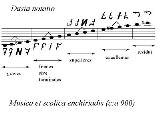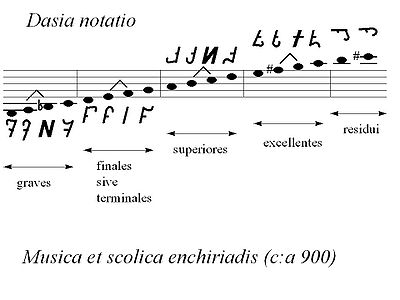
Musica enchiriadis
Encyclopedia
Musica enchiriadis is an anonymous
musical treatise
from the 9th century. It is the first surviving attempt to establish a system of rules for polyphony
in classical music
. The treatise was once attributed to Hucbald
, but this is no longer accepted. Some historians once attributed it to Odo of Cluny
(879-942).
This music theory
treatise, along with its companion commentary, Scolica enchiriadis
, were widely circulated in medieval manuscript
s, typically coupled with Boethius' De Institutione Musica. It consists of nineteen chapters; the first nine are devoted to notation
, modes, and monophonic
plainchant.
Chapters 10-18 deal with polyphonic music. The author shows how consonant
intervals should be used in order to compose or improvise
polyphonic music in early Middle Age
s. A number of examples of organum
, an early style of note-against-note polyphony, are included in the treatise. Musica Enchiriadis also shows rules for performing music and gives some early indications of character for some works, as the Latin words 'morosus' (sadly) or 'cum celeritate' (fast). The last, nineteenth, chapter relates the legend of Orpheus
.
 The scale used in the work, which is based on a system of tetrachord
The scale used in the work, which is based on a system of tetrachord
s, appears to have been created solely for use in the work itself, rather than taken from actual musical practice. The treatise also uses a very rare system of notation, known as Daseian notation. This notation has a number of figures which are rotated ninety degrees to represent different pitches.
A critical edition of the treatises was published in 1981, and an English translation in 1995.
Anonymity
Anonymity is derived from the Greek word ἀνωνυμία, anonymia, meaning "without a name" or "namelessness". In colloquial use, anonymity typically refers to the state of an individual's personal identity, or personally identifiable information, being publicly unknown.There are many reasons why a...
musical treatise
Treatise
A treatise is a formal and systematic written discourse on some subject, generally longer and treating it in greater depth than an essay, and more concerned with investigating or exposing the principles of the subject.-Noteworthy treatises:...
from the 9th century. It is the first surviving attempt to establish a system of rules for polyphony
Polyphony
In music, polyphony is a texture consisting of two or more independent melodic voices, as opposed to music with just one voice or music with one dominant melodic voice accompanied by chords ....
in classical music
Classical music
Classical music is the art music produced in, or rooted in, the traditions of Western liturgical and secular music, encompassing a broad period from roughly the 11th century to present times...
. The treatise was once attributed to Hucbald
Hucbald
Hucbald was a Frankish music theorist, composer, teacher, writer, hagiographer, and Benedictine monk...
, but this is no longer accepted. Some historians once attributed it to Odo of Cluny
Odo of Cluny
Saint Odo of Cluny , a saint of the Roman Catholic Church, was the second abbot of Cluny. He enacted various reforms in the Cluniac monastery system of France and Italy....
(879-942).
This music theory
Music theory
Music theory is the study of how music works. It examines the language and notation of music. It seeks to identify patterns and structures in composers' techniques across or within genres, styles, or historical periods...
treatise, along with its companion commentary, Scolica enchiriadis
Scolica enchiriadis
Scolica enchiriadis is an anonymous ninth-century music theory treatise and commentary on its companion work, the Musica enchiriadis. These treatises were once attributed to Hucbald, but this is no longer accepted....
, were widely circulated in medieval manuscript
Manuscript
A manuscript or handwrite is written information that has been manually created by someone or some people, such as a hand-written letter, as opposed to being printed or reproduced some other way...
s, typically coupled with Boethius' De Institutione Musica. It consists of nineteen chapters; the first nine are devoted to notation
Musical notation
Music notation or musical notation is any system that represents aurally perceived music, through the use of written symbols.-History:...
, modes, and monophonic
Monophony
In music, monophony is the simplest of textures, consisting of melody without accompanying harmony. This may be realized as just one note at a time, or with the same note duplicated at the octave . If the entire melody is sung by two voices or a choir with an interval between the notes or in...
plainchant.
Chapters 10-18 deal with polyphonic music. The author shows how consonant
Consonance and dissonance
In music, a consonance is a harmony, chord, or interval considered stable, as opposed to a dissonance , which is considered to be unstable...
intervals should be used in order to compose or improvise
Improvisation
Improvisation is the practice of acting, singing, talking and reacting, of making and creating, in the moment and in response to the stimulus of one's immediate environment and inner feelings. This can result in the invention of new thought patterns, new practices, new structures or symbols, and/or...
polyphonic music in early Middle Age
Middle age
Middle age is the period of age beyond young adulthood but before the onset of old age. Various attempts have been made to define this age, which is around the third quarter of the average life span of human beings....
s. A number of examples of organum
Organum
Organum is, in general, a plainchant melody with at least one added voice to enhance the harmony, developed in the Middle Ages. Depending on the mode and form of the chant, a supporting bass line may be sung on the same text, the melody may be followed in parallel motion , or a combination of...
, an early style of note-against-note polyphony, are included in the treatise. Musica Enchiriadis also shows rules for performing music and gives some early indications of character for some works, as the Latin words 'morosus' (sadly) or 'cum celeritate' (fast). The last, nineteenth, chapter relates the legend of Orpheus
Orpheus
Orpheus was a legendary musician, poet, and prophet in ancient Greek religion and myth. The major stories about him are centered on his ability to charm all living things and even stones with his music; his attempt to retrieve his wife from the underworld; and his death at the hands of those who...
.

Tetrachord
Traditionally, a tetrachord is a series of three intervals filling in the interval of a perfect fourth, a 4:3 frequency proportion. In modern usage a tetrachord is any four-note segment of a scale or tone row. The term tetrachord derives from ancient Greek music theory...
s, appears to have been created solely for use in the work itself, rather than taken from actual musical practice. The treatise also uses a very rare system of notation, known as Daseian notation. This notation has a number of figures which are rotated ninety degrees to represent different pitches.
A critical edition of the treatises was published in 1981, and an English translation in 1995.

